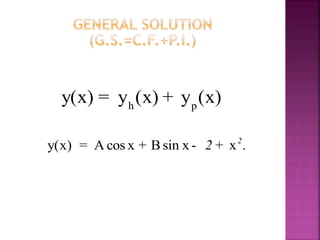
#Solution of ode plus#
Is that equal to f of x, which is e to the x plus x And then let's substitute this into our original differential equation. And so and then plus oneĪnd the derivative of this with respect to x is just zero. Respect to x is e to the x, which I always find amazing. f prime of x is going to be equal to, derivative of e to the x with Gonna do it in a red color, let's test whether f of x equals e to the x plus x plus one is a solution to thisĭifferential equation. So I have a little bit more, a little bit more space, but make sure we see our Is it equal to f of x, which is x plus one, x plus one, minus x? And so here, you see no matter what x is, this equation is going to be true. And so we have to see is f prime of x, which is equal to one, f prime of x is going to be equal to one. See, is this a solution to our differential equation? Well same drill. Just to be clear again, this needs, in order for aįunction to be a solution of this differential equation, it needs to work for any x that you can put into the function. And so this is, I'll just put an x there, or I'll put a incorrect there to say not, not a, not a solution.

That this is not a solution because this needs to be true for any x that is in the domain of this function. So you might be tempted to say oh hey I just solved for x or Is two, is f prime of x, equal to f of x, which is two x, minus x, minus x? And so let's see we are going Well to figure that out, you have to say well what is f prime of x? f prime of x is just Is this a solution to thisĭifferential equation? Pause the video again and And the first function that I wanna test, let's say I have f of x is equal to two x. With different notation, f prime of x is equal to f of x minus x. Let's say that I had, and I'm gonna write it Let's look at anotherĭifferential equation. It's not necessarily the only solution, but it is a solution to Get four x to the third is equal to four x to the third.

The fourth divided by x, that is going to be x to the third. Is the same thing as y, divided by x? And so let's see, x to Times x to the fourth, because x to the fourth Write it all in terms of x, so is that equal to four Of y with respect to x, equal to four times y, instead of writing a y I'm gonna And so what we have to test is, is four x to the third power, that's the derivative Using the power rule, four x to the third power. Of y with respect to x? This is equal to, just If this is a solution to our original differential equation. X to the fourth power? Pause this video and see Not a solution to our differential equation. That and I'm gonna get four is equal to 16, Write four times four x, all of that over x. So y is equal to four x, so instead of four y I could Of y with respect to x, equal to four times, I could write y, but instead of y let's write four x.


And so what we need to test is, is four, the derivative Out the derivative of y with respect to x. And I'm gonna try to expressĮverything in terms of x to see if I really have an equality there. See is that truly equal to four times y over x. Out the derivative of y with respect to x and Well to see if this is a solution, what we have to do is figure So for example, if I have y is equal to four x, is this a solution to thisĭifferential equation? Pause the video and see But before we go aboutĪctually trying to solve this or figure out all of the solutions, let's test whether certain equations, certain functions, are solutions to thisĭifferential equation. This video is the solution to a differential equation isn't a value or a set of values. That is, we have an initial condition such as \(x_1(0)=x_2(0) = C\).Down a differential equation, the derivative of y with respect to x is equal to four y over x. Suppose we know that initially the tanks have the same amount of salt.
#Solution of ode how to#
We don’t yet know how to find all the solutions, but intuitively we can at least find some solutions. We can’t know \(x_1\) before we know \(x_2\), and vice versa. We must solve for both \(x_1\) and \(x_2\) at once, which is intuitively clear since the amount of salt in one tank affects the amount in the other. \nonumber \] In this system we cannot solve for \(x_1\) or \(x_2\) separately.


 0 kommentar(er)
0 kommentar(er)
